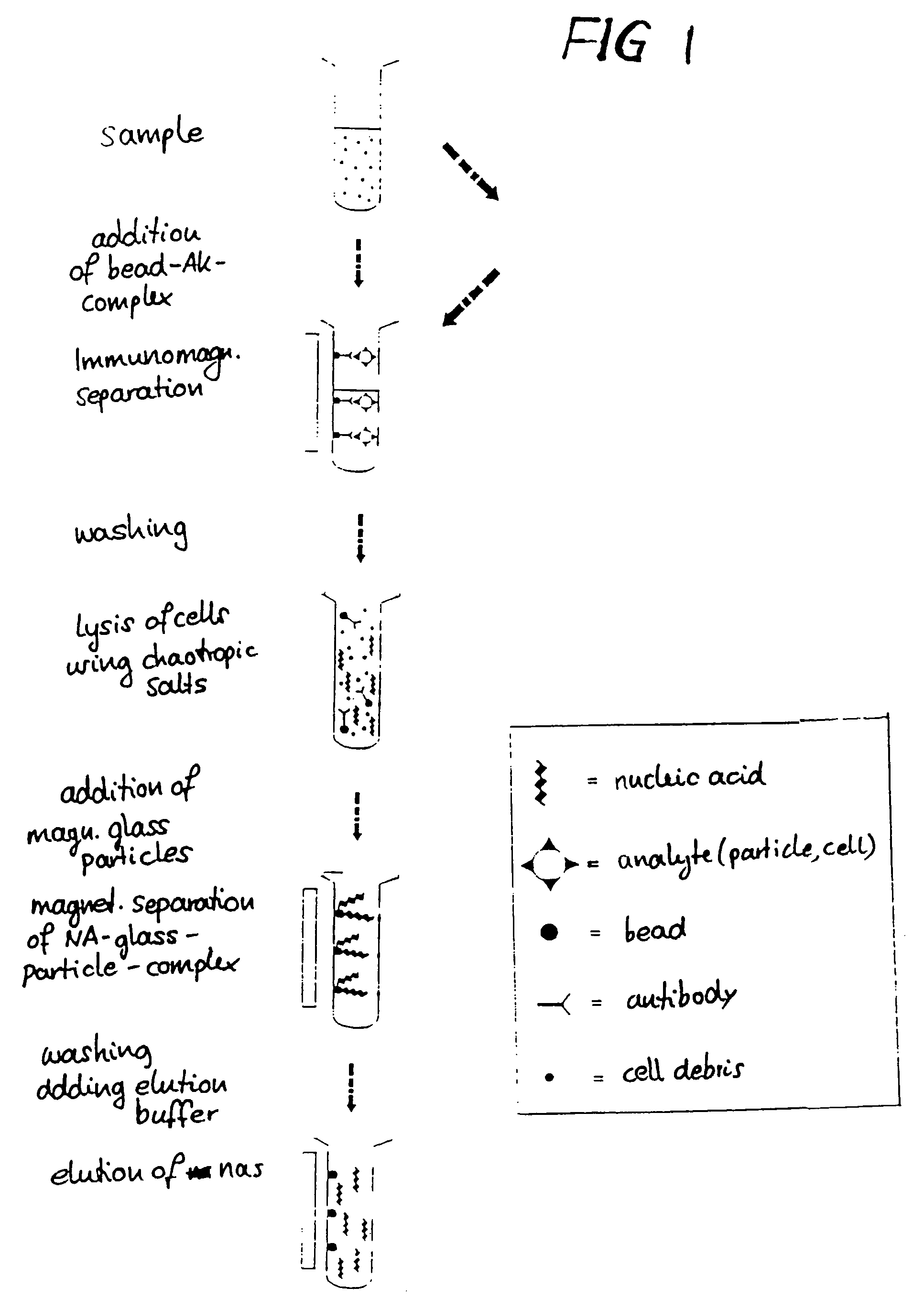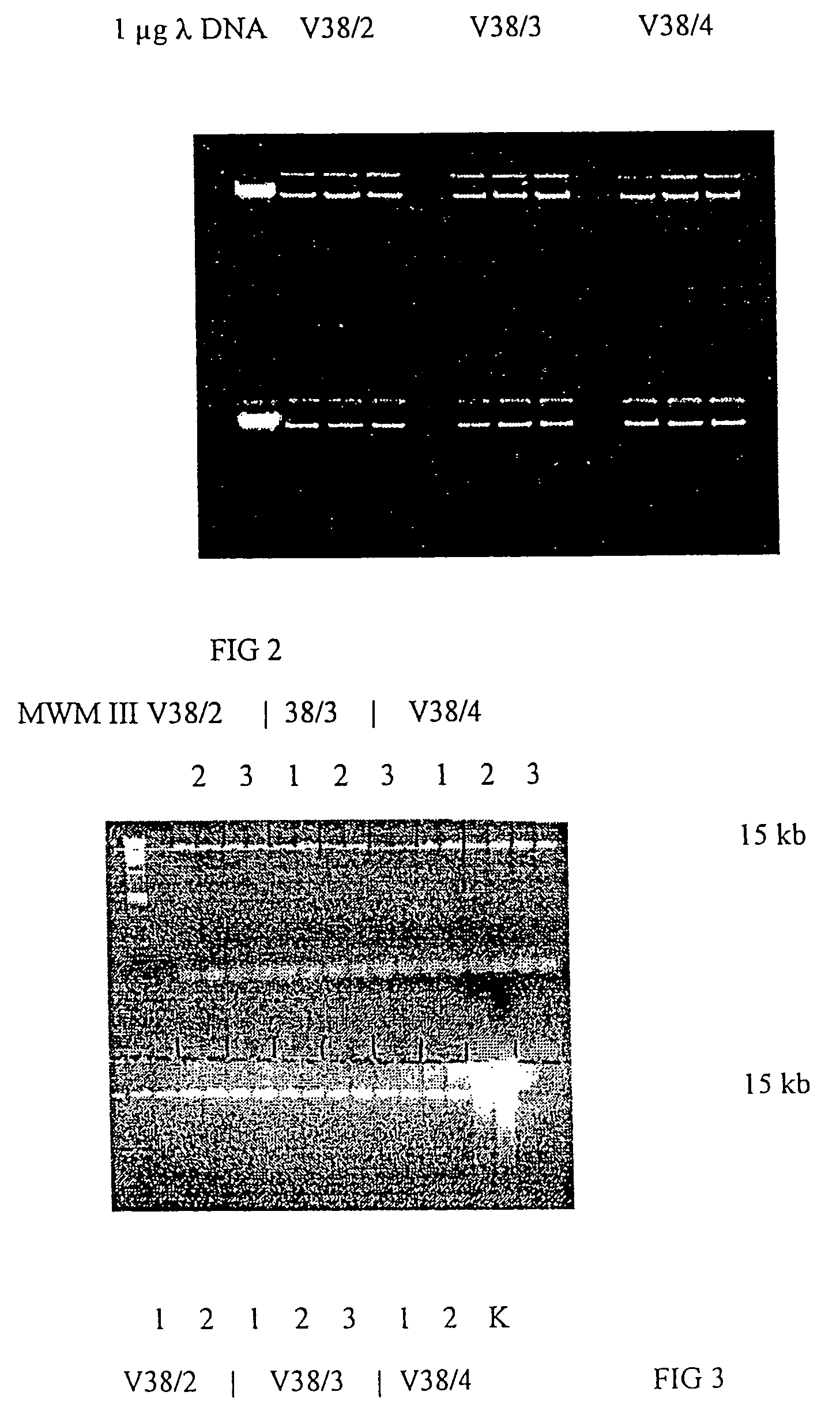Method for separating biological material from a fluid using magnetic particles
a magnetic particle and biological material technology, applied in the direction of microorganism separation, specific peptides, immobilised enzymes, etc., can solve the problems of difficult isolation or measurement, preventing the use of a large quantity of samples, and presenting special challenges in isolating biological materials, especially nucleic acids, to achieve the effect of simple procedur
- Summary
- Abstract
- Description
- Claims
- Application Information
AI Technical Summary
Benefits of technology
Problems solved by technology
Method used
Image
Examples
example 1
Manufacture of the Magnetic Particles According to the Invention
[0065]Six different sols were used. The sols were manufactured as follows:
Sol 1 (SiO2:B2O3=7:3):
[0066]Synthesis was performed in a 250 ml round flask while stirring constantly.[0067]86.6 ml tetraethyl orthosilicate[0068]+7 ml anhydrous, non-denatured ethanol[0069]+14.1 ml 0.15 M HCl
A biphasal mixture is produced. Stir it at room temperature until it becomes a single phase. Add dropwise[0070]+37.8 ml trimethylborate[0071]then keep the sol at 50° C. for 2 hours. Add[0072]+14.1 ml 0.15 M HCl
Sol 2 (SiO2:B2O3=4:1):[0073]Synthesis was performed in a 250 ml round flask while stirring constantly.[0074]100.5 ml tetraethyl orthosilicate[0075]+7 ml anhydrous, non-denatured ethanol[0076]+16.3 ml 0.15 M HCl
A biphasal mixture is produced. Stir it at room temperature until it becomes a single phase. Add dropwise[0077]+25.6 ml trimethylborate[0078]then keep the Sol at 50° C. for 2 hours. Add[0079]+16.3 ml 0.15 M HCl
Sol 3 (SiO2:B2O3=85:...
example 2
Manufacture of GMP1, GMP2, GMP3 and GMP4
[0113]GMP1, GMP2, GMP3 and GMP4 are pigments from different production lots that were obtained from sol 1 (example 1) in a process described in example 1, under the following conditions:
[0114]
ParameterGMP 1GMP 2GMP 3GMP 4Aging of the sol36363636(h) (30° C.)Percentage of pigment515820in sol (g / 100 ml)Nozzle air flow (%)100100100100Air pressure (bar)6663Nozzle temperature135120130143(° C.)Densification534534534615temperature (° C.)subsequent(300° C.)(300° C.)(300° C.)(400° C.)O2-treatment (1 hour)Pigment yieldlowhighmediumhighDNA yieldlowhighhighhigh
example 3
PCR Sample Pretreatment from Human Whole Blood Using Magnetic Glass Particles
Nucleic Acid Isolation
[0115]10 mg each from 3 lots of glass magnetic particles (GMP 2-4) were placed in Eppendorf test tubes. The exact sample weights are indicated in Table 1. Three-fold determinations were performed.
[0116]40 μl proteinase K (20 mg / ml, made from lyophilisate) were added via pipetting to each 200 μl of thawed whole blood and mixed immediately. In the next step, 200 μl binding buffer (6 M guanidine-HCl, 10 mM Tris-HCl, 10 mM urea, 30% Triton X-100, pH 4.4) were added, mixed, and then incubated for 10 minutes at 70° C. 200 μl i-propanol were added, and the preparation was then mixed on the vortex mixer for 10 seconds. The sample was left at room temperature for 20 minutes, then mixed once more for 10 seconds. The magnetic separation step was performed for at least 30 seconds in a magnetic particle separator from Boehringer Mannheim (ID# 1 641 794). The supernatant was removed and analyzed as ...
PUM
| Property | Measurement | Unit |
|---|---|---|
| diameter | aaaaa | aaaaa |
| diameter | aaaaa | aaaaa |
| particle size | aaaaa | aaaaa |
Abstract
Description
Claims
Application Information
 Login to View More
Login to View More - R&D
- Intellectual Property
- Life Sciences
- Materials
- Tech Scout
- Unparalleled Data Quality
- Higher Quality Content
- 60% Fewer Hallucinations
Browse by: Latest US Patents, China's latest patents, Technical Efficacy Thesaurus, Application Domain, Technology Topic, Popular Technical Reports.
© 2025 PatSnap. All rights reserved.Legal|Privacy policy|Modern Slavery Act Transparency Statement|Sitemap|About US| Contact US: help@patsnap.com



